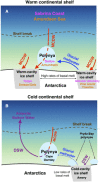Freshening by glacial meltwater enhances melting of ice shelves and reduces formation of Antarctic Bottom Water
- PMID: 29675467
- PMCID: PMC5906079
- DOI: 10.1126/sciadv.aap9467
Freshening by glacial meltwater enhances melting of ice shelves and reduces formation of Antarctic Bottom Water
Abstract
Strong heat loss and brine release during sea ice formation in coastal polynyas act to cool and salinify waters on the Antarctic continental shelf. Polynya activity thus both limits the ocean heat flux to the Antarctic Ice Sheet and promotes formation of Dense Shelf Water (DSW), the precursor to Antarctic Bottom Water. However, despite the presence of strong polynyas, DSW is not formed on the Sabrina Coast in East Antarctica and in the Amundsen Sea in West Antarctica. Using a simple ocean model driven by observed forcing, we show that freshwater input from basal melt of ice shelves partially offsets the salt flux by sea ice formation in polynyas found in both regions, preventing full-depth convection and formation of DSW. In the absence of deep convection, warm water that reaches the continental shelf in the bottom layer does not lose much heat to the atmosphere and is thus available to drive the rapid basal melt observed at the Totten Ice Shelf on the Sabrina Coast and at the Dotson and Getz ice shelves in the Amundsen Sea. Our results suggest that increased glacial meltwater input in a warming climate will both reduce Antarctic Bottom Water formation and trigger increased mass loss from the Antarctic Ice Sheet, with consequences for the global overturning circulation and sea level rise.
Figures




Similar articles
-
Ocean heat drives rapid basal melt of the Totten Ice Shelf.Sci Adv. 2016 Dec 16;2(12):e1601610. doi: 10.1126/sciadv.1601610. eCollection 2016 Dec. Sci Adv. 2016. PMID: 28028540 Free PMC article.
-
Strong ice-ocean interaction beneath Shirase Glacier Tongue in East Antarctica.Nat Commun. 2020 Aug 24;11(1):4221. doi: 10.1038/s41467-020-17527-4. Nat Commun. 2020. PMID: 32839464 Free PMC article.
-
Vigorous lateral export of the meltwater outflow from beneath an Antarctic ice shelf.Nature. 2017 Feb 9;542(7640):219-222. doi: 10.1038/nature20825. Epub 2017 Jan 30. Nature. 2017. PMID: 28135723
-
Glacial meltwater input to the ocean around the Antarctic Peninsula: forcings and consequences.An Acad Bras Cienc. 2022 Apr 8;94(suppl 1):e20210811. doi: 10.1590/0001-3765202220210811. eCollection 2022. An Acad Bras Cienc. 2022. PMID: 35442300 Review.
-
History, mass loss, structure, and dynamic behavior of the Antarctic Ice Sheet.Science. 2020 Mar 20;367(6484):1321-1325. doi: 10.1126/science.aaz5489. Science. 2020. PMID: 32193319 Review.
Cited by
-
Asynchronous Antarctic and Greenland ice-volume contributions to the last interglacial sea-level highstand.Nat Commun. 2019 Nov 6;10(1):5040. doi: 10.1038/s41467-019-12874-3. Nat Commun. 2019. PMID: 31695032 Free PMC article.
-
Intense ocean freshening from melting glacier around the Antarctica during early twenty-first century.Sci Rep. 2022 Jan 10;12(1):383. doi: 10.1038/s41598-021-04231-6. Sci Rep. 2022. PMID: 35013425 Free PMC article.
-
On-shelf circulation of warm water toward the Totten Ice Shelf in East Antarctica.Nat Commun. 2023 Aug 17;14(1):4955. doi: 10.1038/s41467-023-39764-z. Nat Commun. 2023. PMID: 37591840 Free PMC article.
-
Antarctic Peninsula warming triggers enhanced basal melt rates throughout West Antarctica.Sci Adv. 2022 Aug 12;8(32):eabj9134. doi: 10.1126/sciadv.abj9134. Epub 2022 Aug 12. Sci Adv. 2022. PMID: 35960791 Free PMC article.
-
Footprint of sustained poleward warm water flow within East Antarctic submarine canyons.Nat Commun. 2024 Jul 17;15(1):6028. doi: 10.1038/s41467-024-50160-z. Nat Commun. 2024. PMID: 39019883 Free PMC article.
References
-
- Rignot E., Velicogna I., van den Broeke M. R., Monaghan A., Lenaerts J. T. M., Acceleration of the contribution of the Greenland and Antarctic ice sheets to sea level rise. Geophys. Res. Lett. 38, L05503 (2011).
-
- Velicogna I., Sutterley T. C., van den Broeke M. R., Regional acceleration in ice mass loss from Greenland and Antarctica using GRACE time-variable gravity data. Geophys. Res. Lett. 41, 8130–8137 (2014).
-
- Sutterley T. C., Velicogna I., Rignot E., Mouginot J., Flament T., van den Broeke M. R., van Wessem J. M., Reijmer C. H., Mass loss of the Amundsen Sea embayment of West Antarctica from four independent techniques. Geophys. Res. Lett. 41, 8421–8428 (2014).
-
- Li X., Rignot E., Mouginot J., Scheuchl B., Ice flow dynamics and mass loss of Totten Glacier, East Antarctica, from 1989 to 2015. Geophys. Res. Lett. 43, 6366–6373 (2016).
-
- Li X., Rignot E., Morlighem M., Mouginot J., Scheuchl B., Grounding line retreat of Totten Glacier, East Antarctica, 1996 to 2013. Geophys. Res. Lett. 42, 8049–8056 (2015).
Publication types
LinkOut - more resources
Full Text Sources
Other Literature Sources
Molecular Biology Databases

